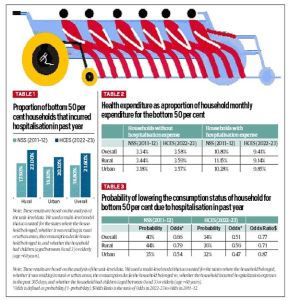THE CONTEXT: The Household Consumption Expenditure Survey (HCES 2022-23) highlights a significant decline in poverty but underscores the persistent vulnerability of the bottom 50 percent of Indian households to medical shocks. This analysis explores the impact of hospitalization expenses on household well-being and consumption status, emphasizing the need for strategic interventions.

THE FINDINGS:
- Increased Incidence of Hospitalisation: The proportion of households in the bottom 50 percent of the population experiencing hospitalization increased from 17 percent in 2011-12 to 22 percent in 2022-23. This rise was observed in both rural (from 18 percent to 23 percent) and urban areas (from 16 percent to 20 percent), indicating improved access to healthcare for the poorest segments of the population.
- Health Expenditure as a Share of Household Expenditure: For households in the bottom 50 percent, health expenditure without hospitalization increased slightly from 3.3 percent to 3.6 percent over the decade. However, for those experiencing hospitalization, the share of health expenditure significantly decreased from 10.8 percent to 9.4 percent, suggesting that hospitalization costs have become relatively more affordable.
- Rural vs. Urban Health Expenditure Trends: In rural areas, the health expenditure ratio for households without hospitalization increased marginally from 3.4 percent to 3.6 percent, while for those with hospitalization, it decreased from 11.15 percent to 9.14 percent. In urban areas, the ratio for non-hospitalized households rose from 3.2 percent to 3.6 percent, and for hospitalized households, it declined from 10.3 percent to 9.9 percent. This indicates a more pronounced improvement in affordability in rural areas.
- The Decline in Consumption Status Due to Hospitalisation: Among the poorest 50 percent, the proportion of households experiencing a decline in consumption status due to hospitalization fell from 40 percent in 2011-12 to 33 percent in 2022-23. This reduction was more significant in rural areas (from 44 percent to 36 percent) compared to urban areas (a 14 percent reduction in odds).
- Reduction in Vulnerability to Health Shocks: The odds of households facing declining consumption due to hospitalization decreased by 23 percent overall. This reduction was more pronounced in rural areas (29 percent reduction in odds) than urban areas (14 percent reduction in odds), highlighting improved resilience to health-related economic shocks.
- Impact of Public Health Policies: The observed trends in improved affordability and reduced vulnerability to hospitalization-related financial burdens are closely associated with public health policies, particularly the Ayushman Bharat Yojana. This policy aims to alleviate the financial burden of hospitalization for poor households, contributing to improved healthcare access and affordability.
THE WAY FORWARD:
- Expand Health Insurance Coverage: The health insurance market in India is projected to reach a market volume of $116.20 billion by 2028, indicating a growing recognition of health insurance as a safeguard against rising healthcare costs. The Ayushman Bharat scheme, despite some operational challenges, has increased healthcare utilization significantly. The scheme must be enhanced by focusing on comprehensive primary healthcare and gradually expanding secondary and tertiary care coverage.
- Enhance Primary Healthcare Access: The WHO highlights primary healthcare as a cost-effective approach to achieving universal health coverage, emphasizing integrated services and community empowerment. Countries like Brazil have successfully implemented family health programs that prioritize primary care. Strengthening India’s National Health Mission (NHM) to improve healthcare infrastructure and services in rural and urban areas can enhance access to primary healthcare.
- Address Social Determinants of Health: Addressing social determinants such as education, sanitation, and nutrition is crucial for reducing vulnerability to health shocks. The WHO emphasizes multisectoral policies to address these determinants. Community health needs assessments to identify and address social determinants effectively.
- Promote Preventive Healthcare and Health Literacy: Preventive healthcare can significantly reduce long-term healthcare costs. For example, routine vaccinations and screenings can prevent severe health issues, reducing the need for costly treatments. The Affordable Care Act in the U.S. includes provisions for preventive services, which have improved health outcomes and reduced costs over time.
- Implement Cost-Effective Healthcare Models: The Eastern Deanery AIDS Relief Program (EDARP) in Kenya demonstrates the effectiveness of community-driven healthcare models focusing on local needs and cost management. Encouraging generic medicines and expanding outpatient facilities can reduce household healthcare costs. Policies that incentivize cost-effective healthcare practices can be beneficial.
- Strengthen Public-Private Partnerships: Public-private partnerships can enhance healthcare delivery and accessibility. Brazil’s success in public-private health initiatives serves as a model for India. The collaboration between the Indian government and private insurers under the Ayushman Bharat scheme has improved access to healthcare services for the poor.
THE CONCLUSION:
Despite improvements in healthcare accessibility, the financial burden of hospitalization remains a critical challenge for India’s poorest households. By expanding insurance coverage and enhancing primary healthcare, India can further reduce vulnerability and promote economic stability among its most vulnerable populations.
UPSC PAST YEAR QUESTIONS:
Q.1 To enhance social development prospects, sound and adequate healthcare policies are needed, particularly in geriatric and maternal healthcare. Discuss. 2020
Q.2 Appropriate local community-level healthcare intervention is a prerequisite to achieving ‘Health for All ‘in India. Explain. 2018
Q.3 Professor Amartya Sen has advocated important primary education and health care reforms. What are your suggestions for improving their status and performance? 2016
MAINS PRACTICE QUESTION:
Q.1 Discuss the impact of hospitalization expenses on household consumption and well-being. Suggest measures that can be implemented to mitigate these vulnerabilities.
SOURCE:
https://indianexpress.com/article/opinion/40-years-ago/forty-years-ago-opposition-9503561/
Spread the Word
